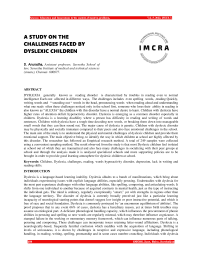A study on the challenges faced by dyslexic children
Автор: D. Anuradha
Журнал: Science, Education and Innovations in the Context of Modern Problems @imcra
Статья в выпуске: 3 vol.5, 2022 года.
Бесплатный доступ
DYSLEXIA generally known as reading disorder is characterized by troubles in reading even to normal intelligence Each one affected in different ways, The challenges includes even spelling words, ,reading Quickly, writing words and “‘sounding out “ words in the head, pronouncing words when reading aloud and understanding what one reads often these challenges noticed only in the school first, someone who loses their ability in reading is also known as “ALEXIA” the children with this disorder have a normal desire to learn. Children with dyslexia have higher rates of attention deficit hyperactivity disorder. Dyslexia is emerging as a common disorder especially in children. Dyslexia is a learning disability where a person has difficulty in reading and writing of words and sentences. Children with dyslexia have a tough time decoding new words, or breaking them down into manageable small words that they can then sound out. The major cause of dyslexia is genetic. Children with dyslexic disorder may be physically and socially immature compared to their peers and also face emotional challenges in the school. The main aim of the study is to understand the physical and mental challenges of dyslexic children and provide them emotional support. The main objective being, to identify the way in which children at school are highly affected by this disorder. The researcher has followed an Empirical research method. A total of 249 samples were collected using a convenient sampling method. The result observed from the study is that most Dyslexic children feel isolated at school out of which they are traumatized and also face many challenges in socializing with their peer groups at school and through the analysis made it is analyzed specialized schools and more supporting policies are to be brought in order to provide good learning atmosphere for dyslexic children at school.
Children, Dyslexia, challenges, reading, words hyperactivity disorder, depression, lack in writing and reading skills
Короткий адрес: https://sciup.org/16010206
IDR: 16010206
Текст научной статьи A study on the challenges faced by dyslexic children
Dyslexia is a language-based learning inability. Dyslexia alludes to a bunch of manifestations, which bring about individuals experiencing issues with explicit language abilities, especially perusing. Understudies with dyslexia for the most part experience challenges with other language abilities, like spelling, composing, and articulating words. It shifts from one individual to another because of acquired contrasts in mental health, just as the type of instructing the individual gets. The mind is ordinary, regularly exceptionally "smart," yet with strengths in regions other than the language territory. The disorder of dyslexia is currently broadly perceived just like a particular learning incapacity of neurological starting points that doesn't suggest low insight or poor instructive potential, and which is free of race and social foundation. Dyslexia is commonly portrayed by 'an uncommon equilibrium of abilities'. The proof proposes that in any event 66% of cases, dyslexia has a hereditary reason, yet at times birth troubles may assume an etiological part. A deficient phonological handling capacity, which influences the procurement of phonic abilities in perusing and spelling so new words are regularly misread, which may therefore influence cognizance. A stamped failure in the working or momentary memory framework, which can influence numerous parts of talking, perusing and composing. These challenges can incorporate issues retaining letter-sound affiliations. Dyslexia is a neurologically-based, frequently familial confusion which meddles with the acquisition of language. Shifting in levels of seriousness, it is shown by challenges in receptive and expressive language, including phonological handling, in reading, writing, spelling, penmanship and in some cases number-crunching. Individuals with dyslexia can likewise have issues with communicating in language, even after they have been presented to superb language models in their homes and top notch language guidance in school. They may think that it's hard to communicate plainly, or to completely fathom what others mean when they talk. Such language issues are frequently hard to perceive, yet they can prompt serious issues in school. Reading and writing problems is often very common in such kids, these may include slow reading speed, feeling distracted while reading, a high proportion of errors while reading anything, confusion of similar words while writing, the spelling problem, awkward handwriting, feeling pressured, etc. It is pivotal to have the option to perceive the indications of side effects of dyslexia. Both cumulative risks and proximal factors can affect children with dyslexia. There are both physical and mental health risks for dyslexic children. Dyslexic children also face social and emotional challenges inclusive of Undeniable degrees of uneasiness and stress have been distinguished as the most characteristic social relations of dyslexia; these will undoubtedly influence execution. An 'alarm' response is capable of dyslexic individuals when put in situations where they can't adapt. The aggregate impact of sluggishness, required by extra exertion at each instructive level, ought not to be thought of. They will in general have negative musings about themselves, that is, a negative mental self portrait. The prior a youngster is evaluated, the sooner the person can acquire the proper guidance and facilities he or she would need to prevail in school. Postponements in distinguishing kids with dyslexia can make a greater understanding issue and a drop in confidence. So it's essential to perceive side effects from the get-go in primary school and start specific pursuing guidance immediately. Kids with dyslexia often feel isolated and that they're not smart as their peers because it's difficult for them to cope up. Hence, the main aim of the study is to understand the challenges of dyslexic children and provide emotional support to them[17-34] .
GOVERNMENT INITIATIVES
The government in our country has taken certain initiatives for the protection and improvement of the dyslexic children. Firstly, The Right of Persons with Disability bill, 2016 addresses people with all kinds of disability, is including dyslexia. It provides some provisions in their favour. Secondly, there have been several Learning Disability (LD) movements in India for the purpose of identifying dyslexic children and also spreading awareness about the same. The CBSE has also amended its Rule 24 of chapter 4 permitting students with visual impairment, physical disability, dyslexia, autism, in PWD act, 1995 to appear for board exam to use amanuensis and be permitted extra time. The four States, Maharashtra, Karnataka, Kerala and Delhi have taken various measures for identification and diagnosis of Specific Learning Disabilities (SLDs) in India.
Comparison with other Countries
Scientific Studies and core Research has shown that Fourteen percent of School-going children in India are found to be dyslexic. Whereas, between five and fifteen percent of Americans have some degree of Dyslexia. It affects one in six persons in the English speaking world. The Condition of Dyslexia is rare among Italian speakers and also Dyslexia is a reading disorder found in about two percent of school children in the West.
Objectives
-
1. To find out the major issues faced by Dyslexic children
-
2. To identify the way in which Dyslexic children are mostly affected at school
-
3. To understand the challenges of Dyslexic children.
-
4. To provide emotional support to Dyslexic children and help them to recognize their strengths.
METHODOLOGY
The Research method followed here is empirical research. A total of 249 Samples have been collected out of which all the samples have been collected by a convenient sampling method. The Samples were collected online through a structured questionnaire. Books, journals, newspapers and many websites have been referred to. The independent variables are Age, Gender, and Educational qualification. The dependent variables are the major result of dyslexia, the most appropriate way to help, the most affecting ingredient and Emotional support. The Statistical tool used here is Graphical representation.
ANALYSIS
-
Figure 1
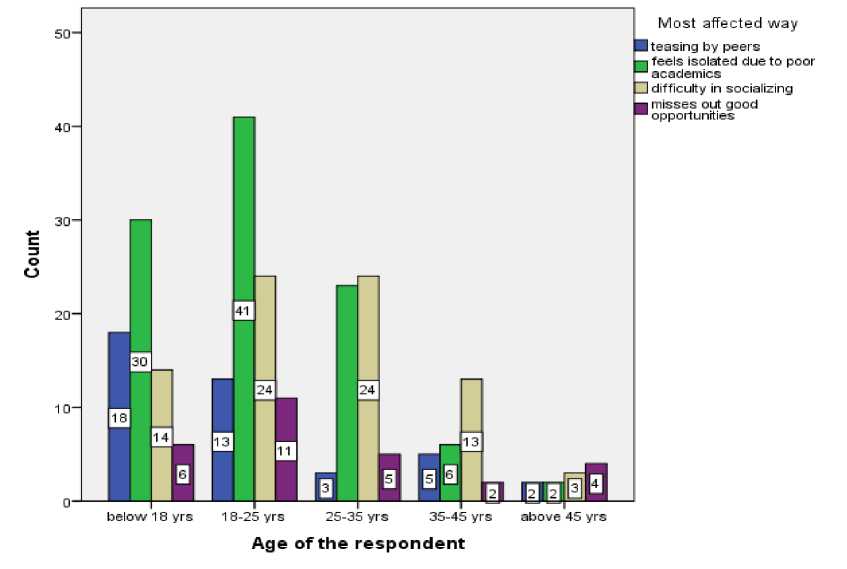
Legend: Figure 1 represents the Age distribution of the sample population and their opinion on the way in which the dyslexic children are mostly affected at school.
Result: The majority of the respondents of the age groups ‘below 18 yrs’, and ‘18-25 yrs’ have felt that the major way in which they are affected is that they feel isolated and neglected in the schools which highly traumatize dislexic children because of non availability of special care in the busy run of normal schooling schedules and the majority of the respondents of the age groups ‘25-35 yrs’ and ‘35-45 yrs’ have felt that they have difficulty in Socializing and ‘above 45 yrs’ feel that these children miss out good opportunities as there is no adherence towards special care for these children in common schools.
Discussion: All of the options given affect the dyslexic children in one way or the other but the poor academic achievements and difficulties in Socializing can affect their mental health too and also this results in missing out on good opportunities that they could use to develop their future.
-
Figure 2
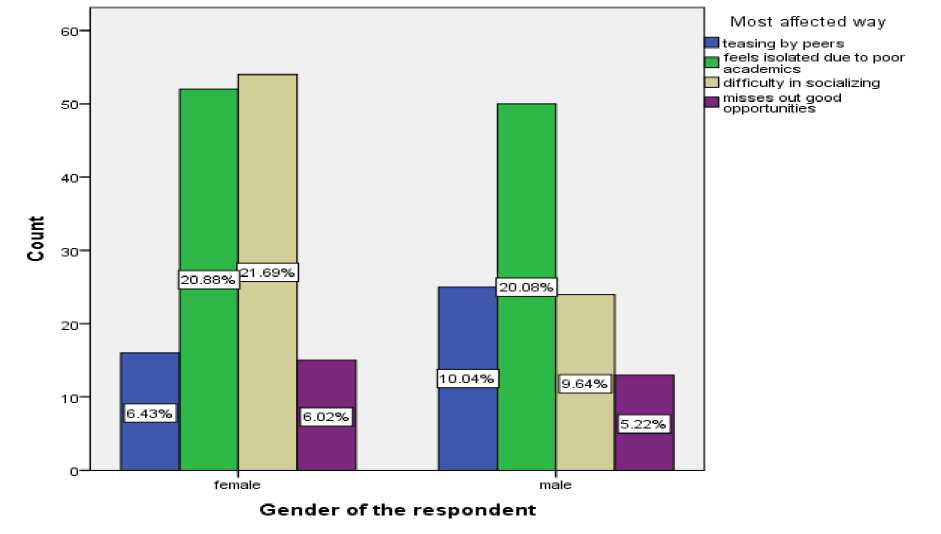
Legend: Figure 2 represents the gender distribution of the sample population and their opinion on the way in which the dyslexic children are mostly affected at school.
Result: The majority of the female respondents (21.69%) have felt that they have difficulty in Socializing and that affects the Dyslexic children majorly whereas the majority of the male respondents (20.08%) have felt that the dyslexic children feel isolated due to poor academics and that affects the dyslexic children the most.
Discussion: Getting socialized is an important aspect of all our lives and dyslexic children because of their disability often have challenges in Socializing and also they have poor academic achievements which affects their career development.
Figure 3
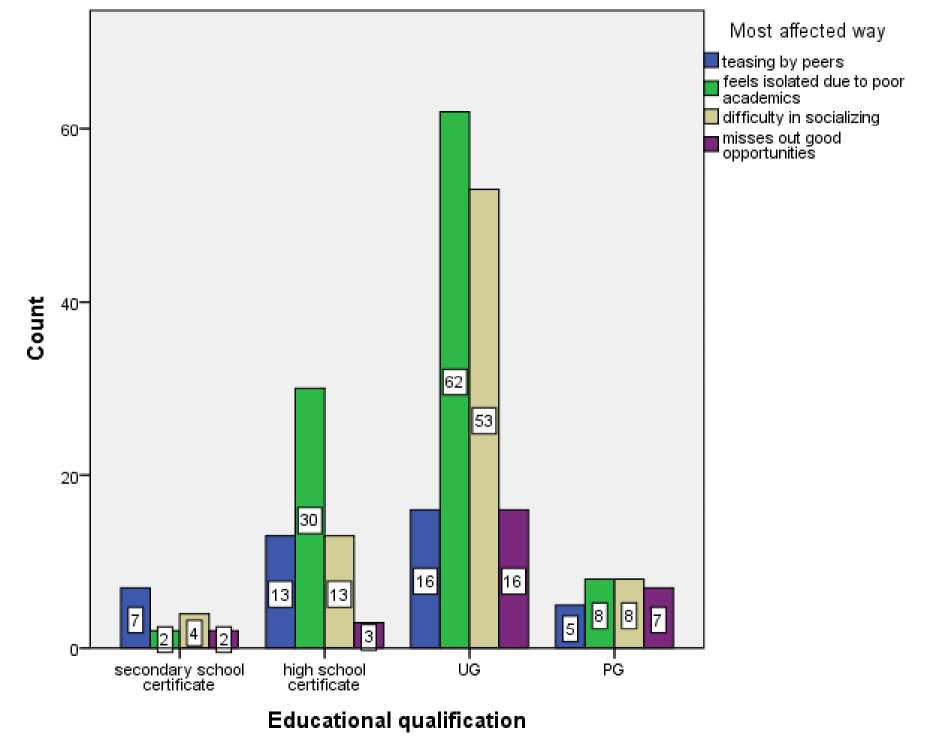
Legend: Figure 3 represents the educational qualification of the sample population and their opinion on the way in which the dyslexic children are mostly affected at school.
Result: The majority of the respondents of all the educational qualifications except secondary school certificates feel that dyslexic children are often isolated in school due to poor academics and that affects them the most. And the majority of the respondents with secondary school certificates feel that they are affected due to teasing by peers.
Discussion: The secondary school certificate respondents are mostly less aged and their major response being teasing by peers affecting the dyslexic children is of course in their direction because they can understand how it feels like and a little more mature people feel that dyslexic children are affected due to poor academic achievements.
-
Figure 4
Major result from dyslexia
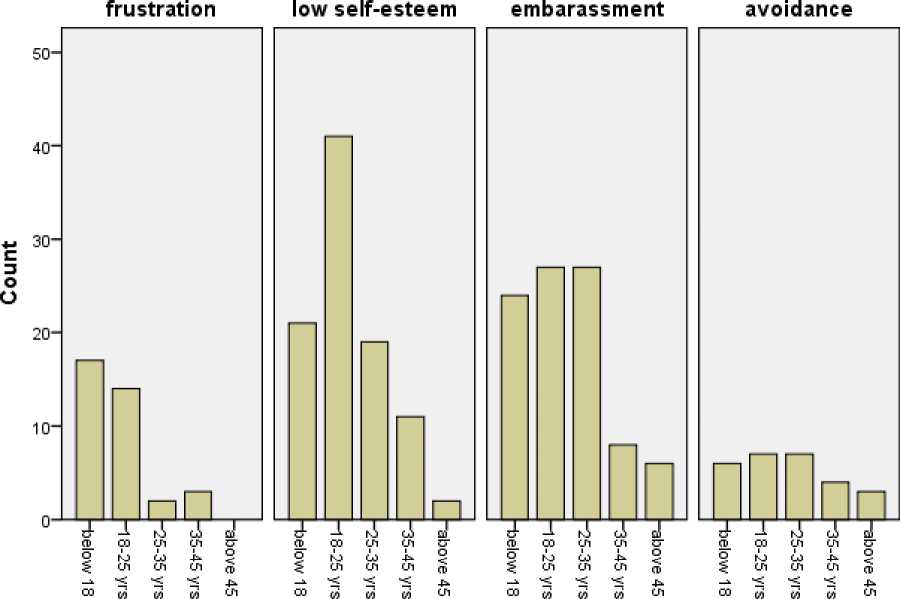
CO coco coco coco co
Age of the respondent
Legend: Figure 4 represents the age distribution and their opinion on which is the major result of dyslexia.
Result: The majority of the respondents of the age ‘below 18 yrs’, ‘25-35 yrs’ and ‘above 45 yrs’ feel that embarrassment is the major impact faced by dyslexial children at school whereas the majority of the respondents of the age ‘18-25 yrs’ and ‘35-45 yrs’ that low self-esteem is the major result for dyslexic children.
Discussion: Dyslexia leads to low self-esteem and embarrassment in most of the dyslexic children is what the result suggests. In the classroom environment they often are not able to move with the flow so they are often thought of as incapable of lowering their self-esteem and leading to embarrassment of such children in front of others.
-
Figure 5
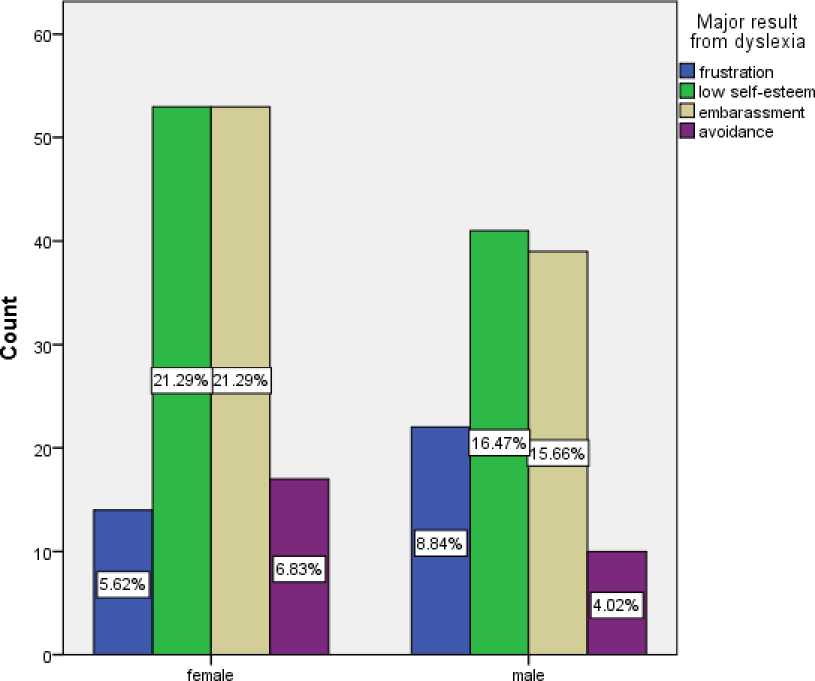
Gender of the respondent
Legend: Figure 5 represents the gender distribution of the sample population and their opinion on which is the major result of dyslexia.
Result: The majority of the female respondents (21.29%) feel that the major result from dyslexia are low selfesteem and embarrassment whereas the majority of the male respondents (16.47%) feel that low self-esteem is the major result from dyslexia for dyslexic children.
Discussion: Both male and female respondents are positive towards dyslexia leading to low self-esteem and causing embarrassment at school. This is because dyslexic children often lose their confidence and feel that they are not strong enough as their peers and also that they might face teasing from peers and scolding’s from teachers, often being embarrassed in school.
-
Figure 6
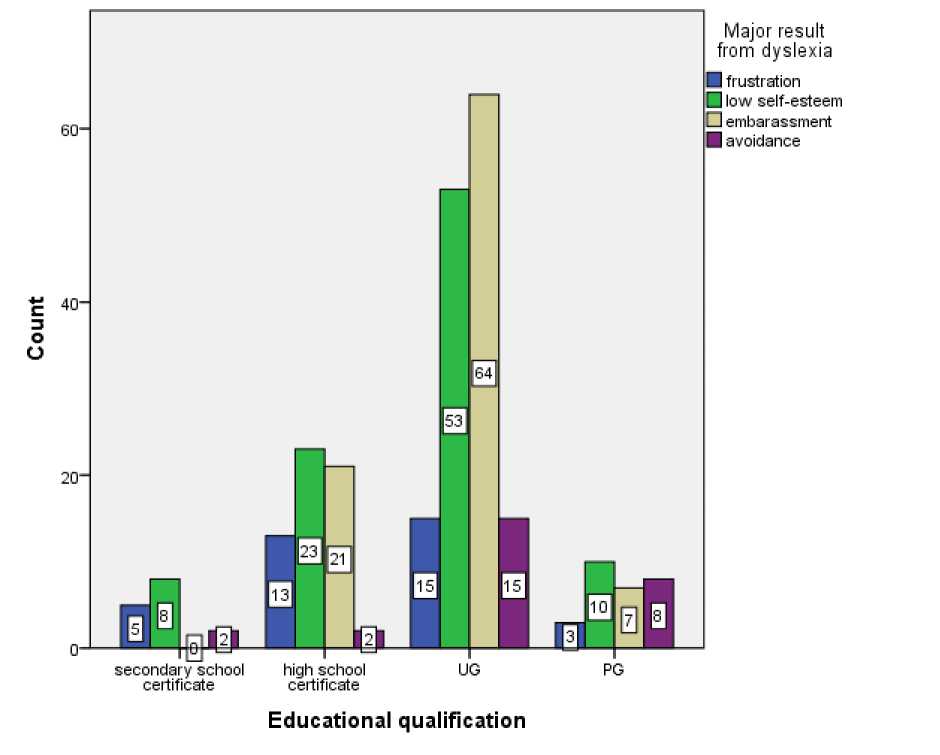
Legend: Figure 6 represents the educational qualification of the sample population and their opinion on which is the major result of dyslexia.
Result: The majority of the respondents of the educational qualification secondary school certificate and high school certificate and PG degree feel that the major result of dyslexia is low self-esteem in the dyslexic children. The majority of the respondents of the educational qualification UG degree feel that embarrassment is the major result from dyslexia for dyslexic children.
Discussion: The major responses suggest that dyslexia leads to low self-esteem in children and that's in a way obvious because these children feel low most of the times and lose their confidence and also the result shows that they often face embarrassment, this can be because often they are not able to cope-up.
-
Figure 7
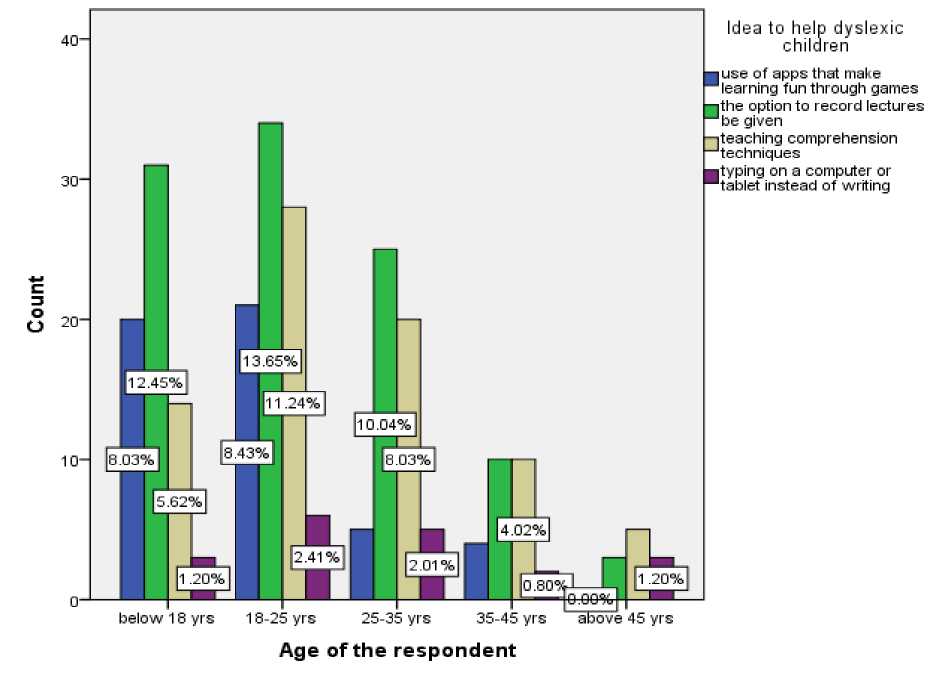
Legend: Figure 7 represents the age distribution of the sample population and their opinion on the idea to help dyslexic children.
Result: The majority of the respondents of the age groups ‘below 18 yrs’, ‘18-25 yrs’, ‘25-35 yrs’, feel that the option to record lectures should be given to dyslexic children to help them at school, whereas ‘35-45 yrs’ feel that equally the option to record lectures and teaching comprehension techniques to them would help and ‘above 45 yrs’ feel that teaching comprehension techniques would help.
Discussion: The option of recording lectures and that of teaching comprehension techniques are both good ideas to help dyslexic children at school as it can help in lessening their difficulties in reading and writing.
Figure 8
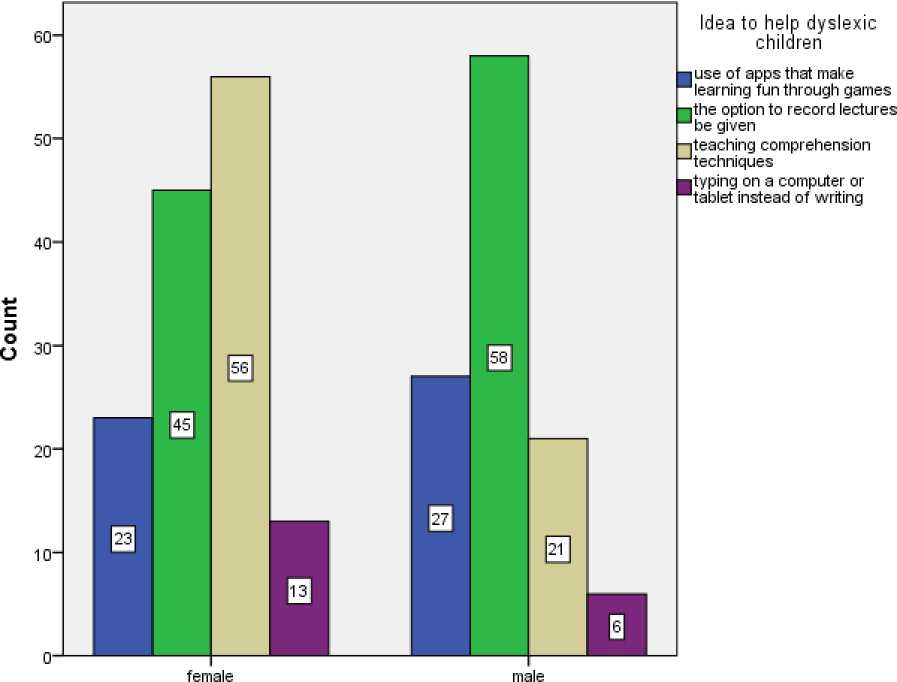
Gender of the respondent
Legend: Figure 8 represents the gender distribution of the sample population and their opinion on the idea to help dyslexic children.
Result: The majority of the female respondents (56) feel that teaching comprehension techniques would help dyslexic children at school and the majority of male respondents (58) feel that the option to record lectures should be given to dyslexic children to help them at school.
Discussion: Both the option of recording lectures and that of teaching comprehension techniques could help the dyslexic children at school as recording lectures make learning a little easier for them and comprehension techniques help them in their reading and writing problems.
LIMITATIONS
One of the major limitations of this study is the sample frame. There is a major constraint in the sample frame as the data was collected online from the respondents because of the current covid situation. So, it was difficult to extrapolate it to a larger population and also that the actual and clear opinions of people remained unexpressed. The physical factors have a larger impact, thus, limiting the study.
CONCLUSION
Dyslexia being a learning disability is not a disease. It's just a different type of ability a person is born with. A comprehension of a dyslexic kid's particular challenges, and what they may mean for the understudy's homeroom execution, can empower the educator to receive showing techniques and procedures to assist the dyslexic youngster with being effectively incorporated into the study hall climate. It is recognized that these kids face significant trouble in Socializing.
The research indicates that the major result that dyslexia leads to in children is low self-esteem and often a feeling of embarrassment at school. These are the offspring of our future and they reserve a privilege to help and support before they build up the ghastly feeling of disappointment which is so tricky. It is necessary to employ new techniques to help dyslexic children at school like teaching using Comprehension techniques. The best way to help the children is to provide them with emotional support. Most importantly, there should be a comprehension from all who instruct them, that they may have numerous gifts and abilities. Their capacities should not be estimated simply based on their troubles in obtaining proficiency abilities. Dyslexic youngsters, similar to all kids, flourish with difficulties and achievement.
SUGGESTIONS
Kids are more fruitful when from the get-go in their lives somebody has been very supportive and empowering, and when they have discovered a region in which they can succeed. Educators and parents can create an extraordinary emotionally supportive network by listening to the Children’s feelings, making them believe that progress is more important than grades. One shouldn't use words like lazy, useless and should try to understand their challenges. Students should be helped in setting realistic goals for themselves. It is likewise vital to be mindful and show everybody the handicap. It's critical to help your kid's endeavors by empowering and helping with perusing. It is also to be noted that in India we have Rights of persons with disabilities Act, 2016, it only generalizes the rights the specific learning disabled persons has in the society and has no stronger implication phrases, and since this learning disorders such as dyslexia has recently emerged there is less awareness and tolerance towards these disabled children therefore their rights are also violated and they are ill treated in schools too. The existing Act wouldn’t suffice the situation of SLD children thereby inclusion of applicable provisions in enhancing the interests of the SLD children should be included and the Act is suggested to be amended on the basis of the suggestions provided therein. Also one should try to give dyslexic child opportunities to build confidence and have success in other areas, such as sports, hobbies, art, and drama and most importantly they must avail a better learning ambience in overall.

